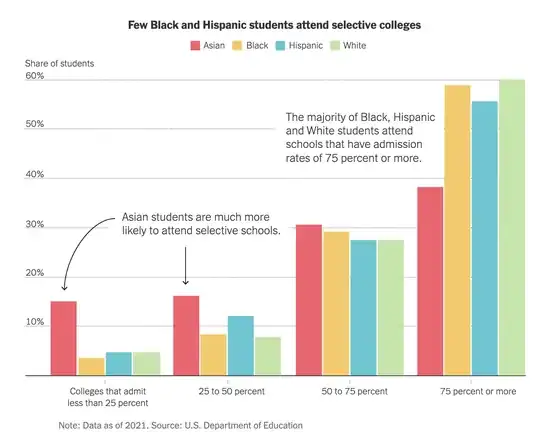As per Why did CJ Roberts apply the Fourteenth Amendment to Harvard, a private school?, the ban on affirmative action only applies to schools that receive federal funding. So... could a school continue with their affirmative action program if they just reject government funds? Or is there some sort of a 'gotcha' that prevents them from doing so in practice?
Can a university continue with their affirmative action program by rejecting all government funding?
1 Answers
Short Answer
Can a university continue with their affirmative action program by rejecting all government funding?
Yes.
The Status Quo
There are twenty-two higher educational institutions in the United States that did this prior to the 2023 ruling (in all but one trivial case, in part, in order to affirmatively escape the requirements of Title VI, so that they could discriminate in furtherance of a religious mission). Most of the schools on the list refuse not only federal but also state and local government aid. Specifically, they are:
Aletheia Christian College (Idaho)
Bethlehem College & Seminary (Minnesota)
Boyce College (Kentucky)
Christendom College (Virginia)
Faith Bible College (Maine)
Grove City College (Pennsylvania)
Gutenberg College (Oregon)
Hildegard College (California)
Hillsdale College (Michigan)
Mid-America Baptist Theological Seminary (Tennessee)
Monticello College (Utah)
Mount Liberty College (Utah)
New College Franklin (Tennessee)
New Saint Andrews College (Idaho)
Patrick Henry College (Virginia)
Pensacola Christian College (Florida)
Principia College (Illinois)
Sattler College (Massachusetts)
Southern Baptist Theological Seminary (Kentucky)
Southwestern Baptist Theological Seminary (Texas)
Weimar University (California)
Wyoming Catholic College (Wyoming)
There used to be more, but most of the hold outs eventually gave in, or ceased to be. Notably, the vast majority of parochial colleges and universities in the U.S. are subject to Title VI because they accept federal funds and federal financial aid.
All of them, except Monticello College in Utah, are non-profit colleges or universities with a religious affiliation or mission. Several are partially, or entirely, seminaries devoted to training future clergy.
Monticello College has only four teaching faculty (including its President) and two administrators, has no more than 30 students at any one time, was apparently established in 2010, was "for profit" until at least 2019, and is unconventional to the point of barely being recognizable as a conventional institution of higher education, for example, including a substantial manual labor component and teaching courses in blocks of two days to three weeks. Monticello also voluntarily adheres to a non-discrimination policy comparable to the one that applies to Title VI institutions.
Only two of them, Grove City College and Hillsdale College, have 1,200 or more students.
By comparison, there are 3,982 colleges and universities in the United States, so this is less than 0.6% of U.S. colleges and universities, and a far smaller percentage of U.S. college students as all of these institutions are all small by college and university standards.
About half of private non-profit colleges and universities (about 800 of them) have 1,000 or fewer students, so about 2.5% of small private non-profit colleges do not receive federal funding, but only 0.25% of larger private non-profit colleges and universities do.
All "for profit" colleges or universities in the U.S. (almost 700 of them) rely upon federal financial aid and/or federal funding.
As a practical matter, almost all of the 99.4% of colleges and universities in the U.S. that rely upon federal financial aid and/or federal funding could not sustainably continue to operate with anything close to their current business models without this federal support. They would either have to close, or would have to radically restructure themselves.
Non-Title VI Considerations
Also, while not quite as stringent as Title VI, the U.S. tax code also denies tax-exempt status to certain non-profits that discriminate based upon race. See 26 U.S.C. § 501(i) (social clubs).
Most higher educational institutions are not subject to this requirement directly, but for example, the Rotarians could not do charitable work for a college that discriminated based upon race as interpreted by the 2023 SCOTUS ruling.
Additional Considerations Regarding Impact
Few private colleges and universities have much of a reason to withdraw from federal funding to allow them to continue affirmative action programs based upon race because not all that many of them have admissions policies which are strongly affected by affirmative action based upon race.
Affirmative action really only has a big impact at colleges and universities that are highly selective, like Harvard and the University of North Carolina, whose admissions policies were litigated in the U.S. Supreme Court. But these universities are highly atypical.
As noted in a recent article in the New York Times, while Harvard admits just 4% of applicants, and UNC admits 20%, just 6% of U.S. four year college students attend a college with an admissions rate of 25% or less (just 22 colleges and universities admit 10% or fewer of the prospective undergraduate students who apply). Another 10% of U.S. four year college students attend a college with an admissions rate of more than 25% but less than 50%. Meanwhile 56% of U.S. four year college students attend a college that admits at least 75% of its applicants.
While the impact of ending affirmative action at highly selective institutions is likely to be significant, this is the exception rather than the rule.
The impact of ending affirmative action based upon race in less selective institutions, while not zero, is barely noticeable. The effects of ending race based affirmative action at these school is also much more easily mitigated with race-neutral programs (like preferences for first generation college students, low income college students, or students with high class ranks in high school) with similar effects in student diversity, in less selective institutions, than it is at highly selective colleges and universities.
Also, less selective colleges and universities already have a disproportionate share of students who currently tend to benefit from affirmative action as show in the chart from the same New York Times story below:
- 257,510
- 16
- 506
- 896
